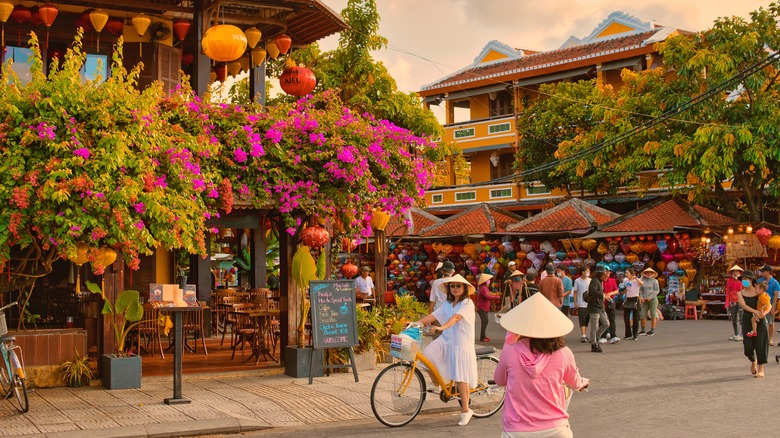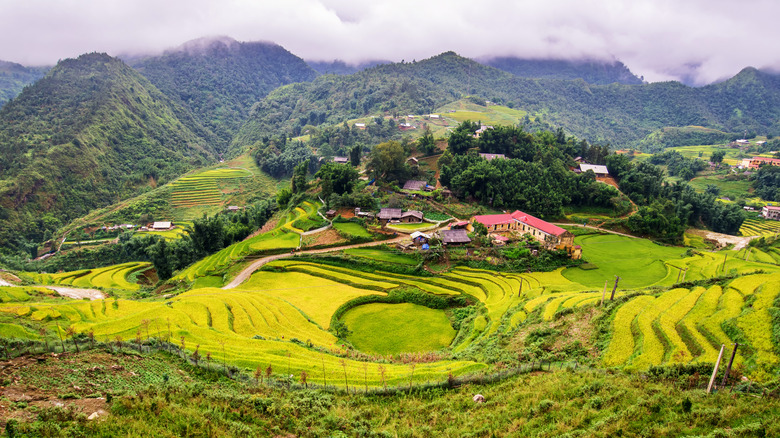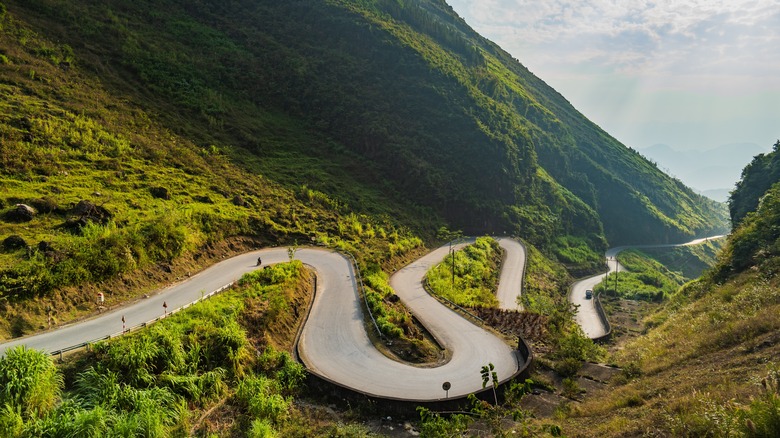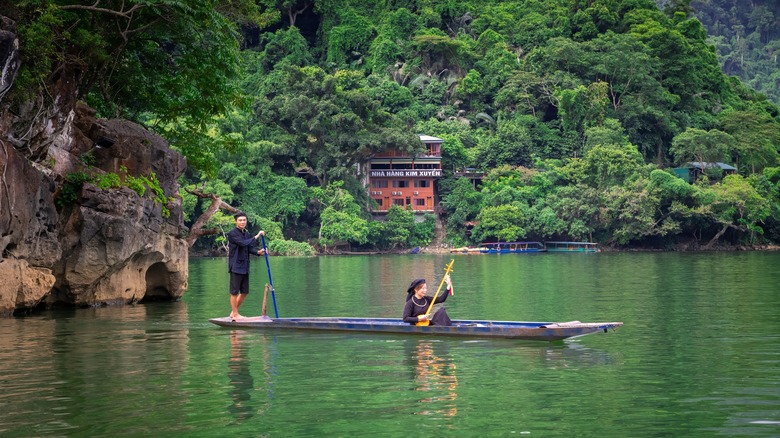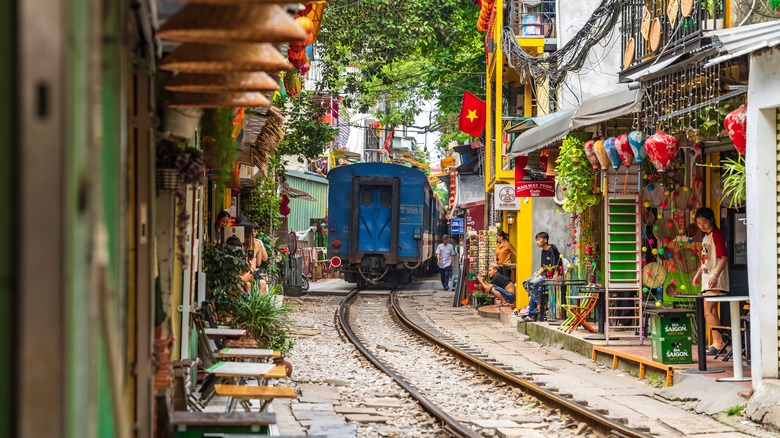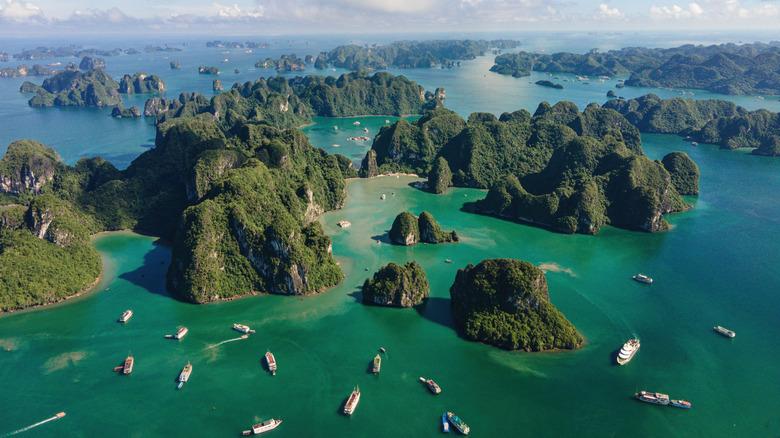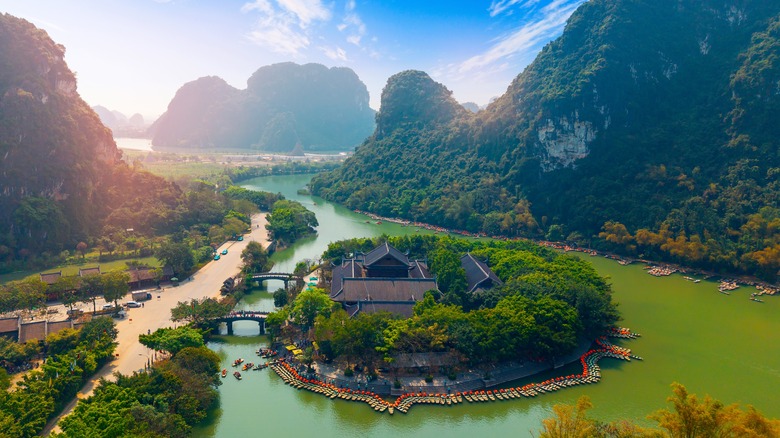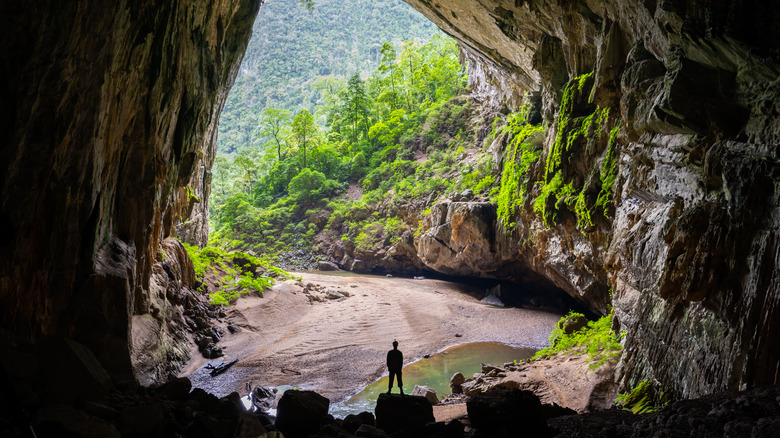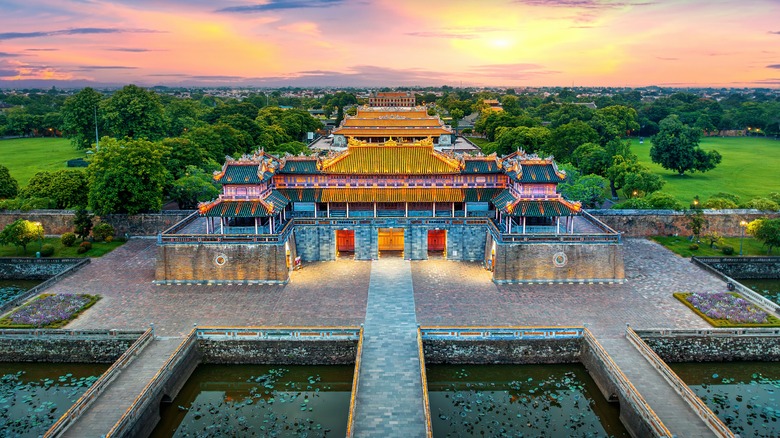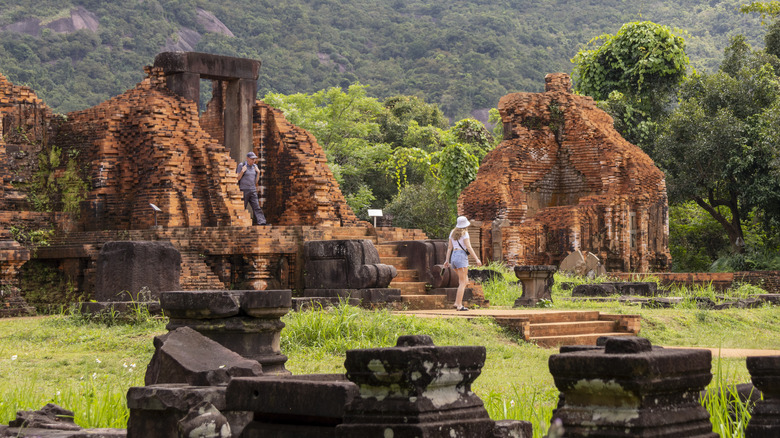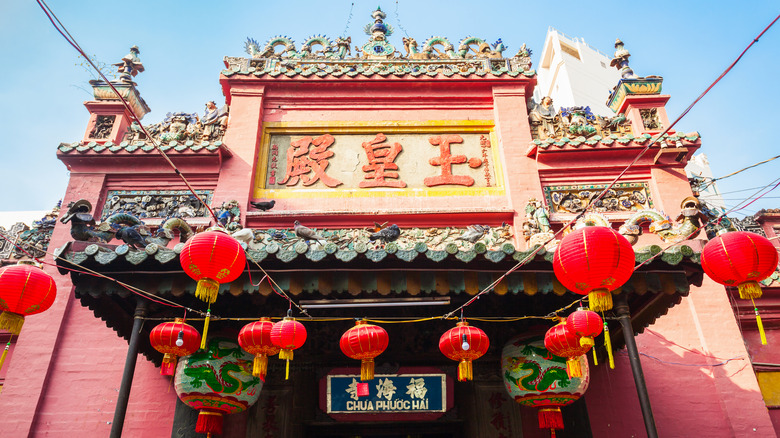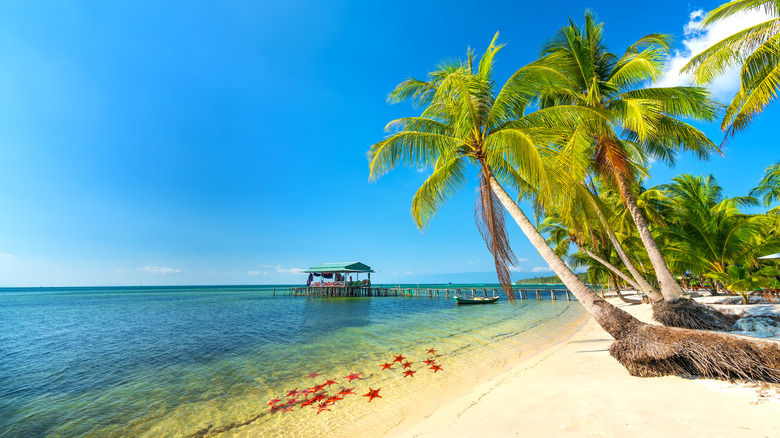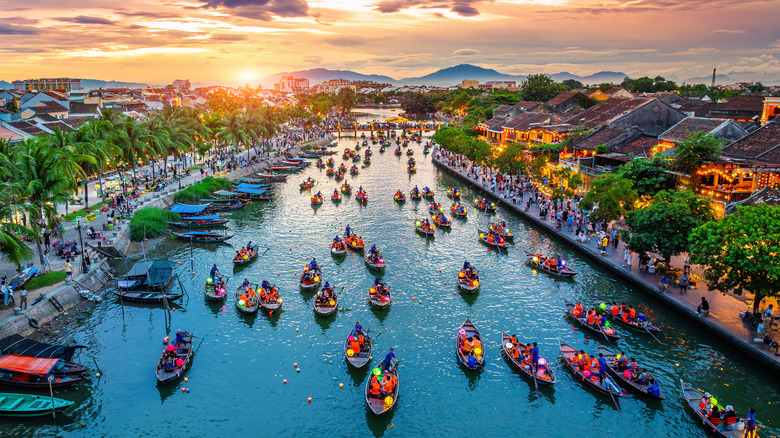Vietnam's Top 11 Tourist Attractions To Check Out On Your First Trip
Whether you're a foodie, history enthusiast, nature lover, or all of the above, there's no shortage of ways to be awed by Vietnam. Geographically embracing Cambodia and Laos, this long and scenic country dips its southernmost point into the Gulf of Thailand, while its northernmost provinces border with China. While its eastern coast offers endless views of the East Vietnam Sea and the South China Sea, its western side is brimming with dramatic mountains and tropical forests.
Vietnam boasts islands with tropical paradise vibes and luxury, riverine landscapes, and stunning mountain drives. Food-wise, you'll also get to enjoy exceptional dishes like pho, which combine fresh vegetables, meat, and noodles. Plus, look no further for a taste of the best spring rolls, egg coffee, banh mi, and "sizzling pancakes" — also known as banh xeo. In the cities, visitors will encounter thriving urban hubs with historic neighborhoods. And in the countryside, you'll be able to observe gorgeous rice paddies, narrow roads through national parks, and experience how tradition meets today. Below, discover 11 destinations and attractions to add to your first Vietnam itinerary, carefully organized from north to south.
Sapa
Nestled against the jaw-dropping backdrop of the Hoang Lien Mountains, the Sapa countryside in the northern Lao Cai province is a must-visit for those seeking incredible landscapes. Tiered rice fields offer amazing photo ops of the rural setting, along with the chance to spot nearly 350 different species of birds. The region's small local communities are also home to a range of ethnic minorities, like the Hmong and Dao, which both originated in southern China, and the Indigenous Tay, Giay, and Xa Pho people. These diverse cultures have mastered the art of farming and animal husbandry, and many craftspeople still work with time-honored textile techniques to create fabrics and garments in incredible colors and patterns, varying by subgroup. The Dao, for example, are renowned for using indigo in their traditional clothing.
Sapa is an incredible destination for hikers, affording beautiful views of farmland, country roads, and dramatic peaks. Fansipan Mountain, the highest peak in all of Indochina, is certainly worth a trek for amazing views — but only if you're up for a bit of a challenge. You'll want to start early if you plan to hike up the Mount Fanispan Trail, as you'll gain nearly 4,400 feet of elevation over the course of 5.5 miles. Rather than trek all the way back down, you can hop on a cable car to return to the municipality of Sapa. This is also a great way to take in sweeping views of the valley and surrounding mountains if you don't fancy a full-day's hike. Back in Sapa, fuel up with a local chicken dish or noodles at May Quan Restaurant.
Ha Giang Loop
One of the most crucial details that tourists should know before traveling to Vietnam is that this country is very motorbike-friendly. In fact, it might be one of the best ways to experience it. Luckily, in Northern Vietnam, where the upland landscape offers sweeping views of mountain pinnacles and canyons, you'll find one of the region's most alluring scenic drives.
Hop on a bike and head out on the Ha Giang Loop, a 230-mile route that begins and ends in the city of Ha Giang. Following QL4C northeast toward Bao Lam and then taking QL34 southwest back to Ha Giang, you'll encounter gorgeous landscapes along the multi-day journey. Some noteworthy sights include the Dong Van Karst Plateau and Heaven's Gate Pass, along with beautiful river valleys, small villages, and hair-raising switchbacks.
If you have an international motorcycle license, the Ha Giang Loop is an ideal journey for you and a companion to take on your own, traveling at your own pace. However, if you're not totally comfortable traveling alone on two wheels, there are also plenty of local companies and hostels that offer group tours. For example, book with an outfit like HagiangGO Motorbikes and Tours for a three-day trip that's limited to 10 people, which will make your adventure social yet seamless.
Ba Be National Park
In the misty mountains of northern Vietnam, Ba Be National Park is a tranquil oasis for lovers of the outdoors who enjoy connecting with beautiful landscapes and traveling at a slower pace. Centering around Ba Be Lake — which itself consists of three interlinked lakes along a meandering, mountain-ringed waterway — the park is an ideal destination for boat tours, caving, and kayaking. Camp overnight to explore some of the more remote parts of the park via hiking and paddling. Alternatively, take a one-day, family-friendly boat cruise to experience the beautiful natural surroundings and visit the atmospheric An Ma Temple, nestled in the trees.
Tours range from single-day adventures to multi-day excursions combining caving, trekking, cycling, boating, and more. It's also a fantastic place for birdwatchers, giving you the chance to spot everything from herons to kingfishers, owls, and more from the boat. Plus, travelers also get to enjoy a wonderful local lunch. Staying overnight here is a treat, too, and you can relax in a traditional stilted homestay like Ba Be Lake View or Huyen Hao.
Hanoi's Old Quarter and Train Street
Vietnam's humming capital of Hanoi is a must-stop for a truly metropolitan experience in the northern part of the country. Its history is multifaceted and can be seen in its layered architectural styles — from French colonial influence in the second half of the 19th century to the influence of neighboring Chinese styles. The Old Quarter, for example, consists of 36 streets, each named for guilds or the goods local merchants used to produce and sell. They have a reputation for being noisy and hectic — with motorbikes, bicycle vendors, and pedestrians traveling every which way — but that's also part of its charm.
You'll also find seemingly endless options for food and shopping. Keep an eye out for numerous small, historic pagodas constructed by Chinese immigrants who settled in the Old Quarter. And travel back in time with a visit to a preserved 19th-century house on Ma May Street, glimpsing into what life was like more than 100 years ago.
Finally, you won't want to miss one of the most famous thoroughfares in Hanoi, which winds its way through a residential area in the Old Quarter: Train Street. This narrow passage is used by trains several times throughout the day, and locals who live beside it have opened small cafes that welcome you to sit down and enjoy a thrilling drink while you watch the heavy engine trundle just past your feet along the narrow route.
Ha Long Bay
One of the most iconic landscapes in Vietnam — which also happens to be one of the cheapest travel destinations in the world — is the awe-inspiring Ha Long Bay. At more than 250 square miles large, it's home to the Cat Ba Archipelago, which consists of 1,133 islands and islets that jut dramatically out of the water. As you can imagine, exploring this area by boat is a must. That way, you'll get to see the unique limestone karst tower formations up-close. There's also a cruise for every style, no matter if you want to take an afternoon jaunt with the whole family, or enjoy a romantic and luxurious multi-day escape.
Most day tours include a stop at Ti Top Island, where you can explore a large cave, kayak along the cliffs, and relax on the boat. Alternatively, you can book a two- or three-day itinerary aboard the glamorous Scarlet Pearl yacht, which features hotel pick-up and drop-off in Hanoi (about two hours away).
Prices range from roughly $40 per adult for a day cruise to upwards of $750 per person for deals that combine 5-star hotel stays with high-end cruise options. Keep in mind that it can get a little crowded in Ha Long Bay — you certainly won't be alone — so if you're looking for something slightly more off the beaten path, you're better off booking a trip that also includes a stop at the more secluded Lan Ha Bay.
Ninh Binh
For amazing landscapes that will get you away from the crowds, head to gorgeous Ninh Binh. It's known fondly as "Ha Long Bay on Land" for its towering rock formations, in addition to expansive sacred sites and meandering rivers. Atop a mountain called Hang Mua, climb the 500 steps that have been carved right into the stone and arrive at the overlook for panoramic views of lush rice paddies alongside the natural limestone towers of the UNESCO-designated Trang An landscape.
Additionally, you can also explore this magical destination by water on a unique sampan tour, where guides row boats with their feet rather than their hands. Hop aboard one at either Tam Coc or Trang An docks, and take in the glorious, nearly vertical limestone karst towers. History buffs will surely appreciate the visit, as caves in the area contain evidence that humans have been continuously living in this valley for more than 30,000 years.
In Ninh Binh, you can also glimpse into Vietnam's rich history in one of its early capitals, the small city of Hoa Lu. If architecture is your thing, you'll definitely want to stop at the largest Buddhist temple complex in Vietnam, Bai Dinh Temple. Covering nearly 2 square miles in total, this sacred site includes ancient buildings that visitors can access after climbing a few hundred steps. Also housed within buildings both old and new is a collection of more than 500 hand-carved Buddha statues.
Phong Nha-Ke Bang National Park
As it turns out, Vietnam happens to be home to the largest cave in the world. Located within Phong Nha Ke-Bang National Park, Hang Son Doong takes the cake as the biggest cavern on Earth in terms of volume: It's more than 5 miles long and its internal space is thought to measure upwards of 1.4 billion cubic feet.
To explore the caves in all their glory, we suggest booking a tour with operators like Oxalis, which offers multi-day treks into the darkness for a once-in-a-lifetime experience. That said, these adventures typically book up well over a year in advance (reservations for 2026 are now closed), so you'll definitely want to plan ahead.
While gloriously big caves are a primary draw to Phong Nha Ke-Bang National Park — there are at least 300 of them to see — there's much more to experience beyond going underground. Trail enthusiasts can hike along scenic trails like the Phong Nha Botanical Garden Loop, a 1.9-mile round-trip route that introduces you to the diverse tropical flora of the mountains. If wheels are more your style, rent a bike and head to the nearby village of Bong Lai in its namesake valley. It's a well-known stop for farm-to-table eats like fresh vegetables and grilled chicken to-go along with cold beer. The local watering hole is called The Pub with Cold Beer, in fact!
Hue and the Imperial Citadel
Before Hanoi was declared the capital of both North and South Vietnam in 1976, the city of Hue was the imperial center of the Nguyen dynasty from 1802 to 1945. Today, it's an under-the-radar city that offers unique cultural experiences and stunning nature. The royal family built astonishing buildings and monuments that demonstrated their power and prestige, and you can wander around the elaborate palaces, gardens, pavilions, tombs, and moat of the Hue Citadel. The site is guarded by a number of remarkable gates, decorated with lavish sculptures, patterns, and colors.
To take in some of Hue's most impressive landmarks — like the striking, seven-story Thien Mu Pagoda — hop aboard a Perfume River cruise. Itineraries, like one offered by Adventure Journey, provide access to the Hue Imperial Citadel, a number of royal tombs and mausoleums, and even stop by a one-of-a-kind abandoned waterpark attraction on the shore of Thuy Tien Lake.
Alternatively, another popular tour option is to explore via motorbike for a more adventurous excursion into the countryside. There, you'll have the opportunity to walk onto the ornate, roofed Thanh Toan Bridge. Built in 1776, it's located just 5 miles southeast of Hue. Make sure you don't miss a stop at Vong Canh Hill on the way there, so that you can take in beautiful views over the surrounding landscape.
Hoi An and My Son
Designated a UNESCO World Heritage site in 1999, the ancient fishing port town of Hoi An is incredibly well-preserved. Its buildings and layout tell the story of what life was like between the 15th and 19th centuries, as local residents were joined by settlers from China, Japan, and Europe along the Thu Bon River. Visit the ornate Japanese Bridge for a postcard-worthy photo op, or tour the stunning Tan Ky House to experience one of the oldest merchant homes that's still standing at more than 200 years old.
After soaking up some history, grab a bite to eat at QQ Restaurant, where you can try local delicacies like cao lau, a regional noodle dish. It's a popular spot, though, so you may have to wait a little bit for a seat. That said, it's definitely worth it! Meanwhile, shopaholics can get their fill at one of the many tailor shops in town that can recreate pretty much any item of clothing from a single photo.
Hoi An is also the gateway to a spectacular archaeological site about an hour's drive west of town called My Son. The sacred complex — part of the ancient Champa Kingdom — was first established in the 4th century before being abandoned in the 1200s. Made of fired brick and stone, and decorated with carved reliefs, the temples of the My Son site are a striking testament to a unique side of Vietnamese culture that derived some of its beliefs from Indian Hinduism.
Ho Chi Minh City (Saigon)
Whereas Hanoi buzzes with energy in the north, Ho Chi Minh City is Vietnam's southern commercial hub, and its population is about 9.8 million and growing. Called Saigon prior to 1976, it was later renamed after the communist leader Ho Chi Minh. However, it's common to hear it still referred to as Saigon.
In the center of this thriving, humming metropolis sits District 1 and Dong Khoi Street, which is something of a highlight reel of the city's rich architecture and history, combined with today's luxury shopping, restaurants, and hotels. It's also in District 1 where you'll find the unique, 19th-century Saigon Notre Dame Cathedral — a prime example of French colonial architecture.
Just a few minutes' drive north, visitors can explore the historic area of Da Kao, where you don't want to miss the blazing pink Jade Emperor Pagoda. Offering free admission, you can soak up the remarkable scent of incense as you tour its sacred spaces. Meanwhile, history buffs will rejoice with a visit to the striking HCMC History Museum, which sits next to the zoo. In fact, in terms of museums, Ho Chi Minh City has one-of-a-kind options well worth a visit. This includes the War Remnants Museum and the Museum of Traditional Vietnamese Medicine — which is also known as the FITO Museum. The latter is situated within District 10, away from the touristy hubs, where you can explore five stories featuring thousands of jars, vials, devices, and other artifacts related to the country's traditional healing practices. Finally, for a more immersive historical experience, venture about an hour northwest of the city to the Cu Chi Tunnels. Here, you can crawl through an underground network of narrow tunnels that served as a vital base for the Viet Cong during the Vietnam War.
Phu Quoc Island
If all-inclusive resorts, palm-lined beaches, and glittering tropical waters are the kinds of things you crave in Vietnam, look no further than Phu Quoc Island. Known for its glistening white sand, it's often called "Pearl Island," and it takes environmental conservation and cultural preservation efforts seriously. Boasting more than 93 miles of coastline, there's no shortage of ways to enjoy this haven, which averages around a comfortable 80 degrees Fahrenheit year-round. Visit in the dry season between October and March for cooler temperatures, or, if you're a heat seeker, April and May will be hotter but with more rain.
Like a lot of places in Vietnam, Phu Quoc Island has an excellent culinary side. In fact, you'll find some of the best fish sauce in the country here. In the Starfish Beach area, on the northwest coast, stop into Nha Tren Bien — a floating restaurant serving up fresh-caught seafood along with glorious views of the turquoise sea. You can even book a fishing experience with them to immerse yourself in the local tradition.
After you've enjoyed a full day on the water, or simply kicked back at the beach, there are numerous options for places to cozy up in comfort. The area is brimming with resort options — like Vinpearl Resort & Spa Phu Quoc and Lahana Resort Phu Quoc & Spa — known for luxurious rooms, pools, and affordable prices. Alternatively, for a truly budget-friendly option, don't overlook the charm of a hostel like 9Station or The Vibe House.
Methodology
To round up the best tourist attractions and destinations to visit on your first trip to Vietnam, we researched major tourism websites like VietnamTourism.gov, Vietnam.travel, OriginVietnam.com, VietnamDiscovery.com, and AhoyVietnam.com, along with specific information about destinations, like BaBeNationalPark.com.vn. We also scoured through social media profiles for local restaurants, travel agencies, and tour guides.
In many cases, we also referenced information compiled by UNESCO, which lists nine places in Vietnam among its World Heritage sites, and consulted a wide array of reviews, ratings, and discussions on sites like AllTrails, TripAdvisor, Google Maps, and Reddit to gain a better impression of a range of visitors' experiences and identify all of the different characteristics that make these places worth putting at the top of your itinerary.
